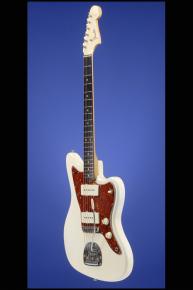An Exceptionally Fine
1963 Olympic White Jazzmaster
This great surfing guitar weighs 8.20 lbs. and has a fat nut width of just under 1 11/16 inches and a scale length of 25 1/2 inches. Solid alder body, one-piece maple neck with a medium profile and veneer rosewood fretboard with 21 frets and clay dot position markers. Large headstock with matching Olympic White finish and decal with "Fender" logo in gold with black trim, "Jazzmaster" in black beside it, and "With Synchronized Floating Tremolo" and five patent numbers in black below it (in two lines): "PAT. 2,960,900 2,972,923 3,143,028, 2,741,146/DES. 186,826." "Offset Contour Body Pat. Pending" decal at the ball end of the headstock. Individual single-line Kluson Deluxe tuners with oval metal buttons. Four-bolt neck plate with serial number ("L31247") between the top two screws. Two large white rectangular six-polepiece pickups with huge outputs of 8.73k and 8.24k. Four-layer (tortoiseshell/white/black/white) celluloid pickguard with thirteen screws. Two master controls (one volume, one tone) with white plastic knobs, plus three-way pickup selector switch and jack socket on the treble side of the pickguard, two roller knobs (one volume, one tone) plus two-way circuit selector (rhythm/lead) slide switch on the bass side of the pickguard. Jazzmaster bridge and integrated tailpiece and tremolo. The neck is stamped: "4 [Jazzmaster] AUG 63B." The pots are stamped: "137 946," "137 947," and "137 950" (CTS November and December 1959). This is an excellent guitar, in exceptionally fine (9.00) and totally original condition. There is some minor finish checking, but absolutely no belt buckle wear on the back of the guitar. Some small flecks of the plush lining from the case have adhered in places to the treble edge of the guitar (which is quite common on light colored guitars which have sat in their cases for long periods of time). Housed in its original Fender light brown Tolex hardshell case with brown leather ends and dark orange plush lining (9.00).
"The Jazzmaster first appeared in Fender sales material during 1958, and at some $50 more than the Strat it became the new top-of-the-line model...Immediately striking to the electric guitarist of 1958 was the Jazzmaster's unusual offset-waist body shape...For the first time on a Fender, the Jazzmaster featured a separate rosewood fingerboard glued to the customary maple neck...The Jazzmaster's floating vibrato system was new, too, and had a tricky 'lock-off' facility aimed at preventing tuning problems if a string should break. The controls were certainly elaborate for the time…A small slide-switch selected between two individual circuits, offering player-preset rhythm and lead sounds. The idea was a good one: the ability to set up a rhythm sound and a lead sound, and switch between them. But the system seemed over-complicated to players brought up on straightforward volume and tone controls. The sound of the Jazzmaster was richer and warmer than players were used to from Fender. The name Jazzmaster had not been chosen at random, for Fender was aiming this different tone at jazz players, who at the time largely preferred hollowbody electrics, and principally those by Gibson. However, jazz guitarists found little appeal in this new, rather difficult solidbody guitar -- and mainstream Fender players largely stayed with their Stratocasters and Telecasters" (Tony Bacon, 50 Years of Fender, p. 26). Much to Fender's surprise, however, the Jazzmaster turned into the best surf guitar ever conceived.
Translate:









